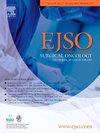胆管内乳头状瘤的临床病理及预后分析:双中心回顾性研究
IF 3.5
2区 医学
Q2 ONCOLOGY
引用次数: 0
摘要
背景IPNB的确切临床特征和预后仍然具有挑战性。需要更多的研究来加强对这种疾病的了解。方法回顾性分析2013年1月至2024年5月两所医疗中心收治的123例IPNB患者的临床资料。比较不同亚组间IPNB的临床病理特征。通过回归分析确定侵袭性IPNB的危险因素和IPNB的生存预测因素。通过生存和复发分析评估IPNB患者的预后。结果绝大多数肿瘤位于肝外胆管(51.2%),42.3%位于肝内胆管,6.5%呈弥漫性分布。23例(18.7%)诊断为低级别发育不良,41例(33.3%)诊断为高级别发育不良,其余59例(48.0%)诊断为浸润性癌。33.3%的病例有粘蛋白分泌。局灶性胆管壁增厚和胰胆管畸形是侵袭性IPNB的独立危险因素。1年、3年和5年的总生存率分别为97.4%、77.2%和70.1%。对于所有IPNB患者,肝外类型和浸润性癌的存在是生存的独立预测因素。在侵袭性IPNB中,肝外类型、局部侵袭和血管侵袭与较差的生存率相关。结论IPNB的临床病理特征在亚组间具有明显的异质性。早期诊断和及时的手术干预对于优化患者的长期预后至关重要。本文章由计算机程序翻译,如有差异,请以英文原文为准。
Clinicopathological and prognosis analysis of intraductal papillary neoplasm of the bile duct: A dual-center retrospective study
Background
The precise clinical features and prognosis of IPNB remain challenging to define. More research is needed to enhance understanding of the disease.
Methods
The study retrospectively analyzes the clinical data of 123 patients with IPNB from two medical centers during January 2013 and May 2024. The clinicopathological characteristics of IPNB were compared across subgroups. Risk factors for invasive IPNB and survival predictors of IPNB were identified by regression analysis. The prognosis of patients with IPNB was evaluated through survival and recurrence analysis.
Result
The majority of tumors (51.2 %) were located in the extrahepatic bile ducts, 42.3 % were in the intrahepatic bile ducts, and 6.5 % exhibited diffuse distribution. 23 patients (18.7 %) were diagnosed with low-grade dysplasia, 41 patients (33.3 %) were diagnosed with high-grade dysplasia, and the remaining 59 patients (48.0 %) were diagnosed with invasive carcinomas. Mucin secretion was observed in 33.3 % of cases. Focal bile duct wall thickening and pancreaticobiliary maljunction were identified as independent risk factors for invasive IPNB. The 1-year, 3-year, and 5-year overall survival rates were 97.4 %, 77.2 %, and 70.1 %, respectively. For all IPNB patients, the extrahepatic type and presence of invasive carcinoma were independent predictors of survival. In invasive IPNB, the extrahepatic type, local invasion, and vascular invasion were associated with worse survival.
Conclusion
The clinicopathological features of IPNB exhibited significant heterogeneity across subgroups. Early diagnosis and timely surgical intervention are critical for optimizing patients’ long-term outcomes.
求助全文
通过发布文献求助,成功后即可免费获取论文全文。
去求助
来源期刊

Ejso
医学-外科
CiteScore
6.40
自引率
2.60%
发文量
1148
审稿时长
41 days
期刊介绍:
JSO - European Journal of Surgical Oncology ("the Journal of Cancer Surgery") is the Official Journal of the European Society of Surgical Oncology and BASO ~ the Association for Cancer Surgery.
The EJSO aims to advance surgical oncology research and practice through the publication of original research articles, review articles, editorials, debates and correspondence.
 求助内容:
求助内容: 应助结果提醒方式:
应助结果提醒方式:


